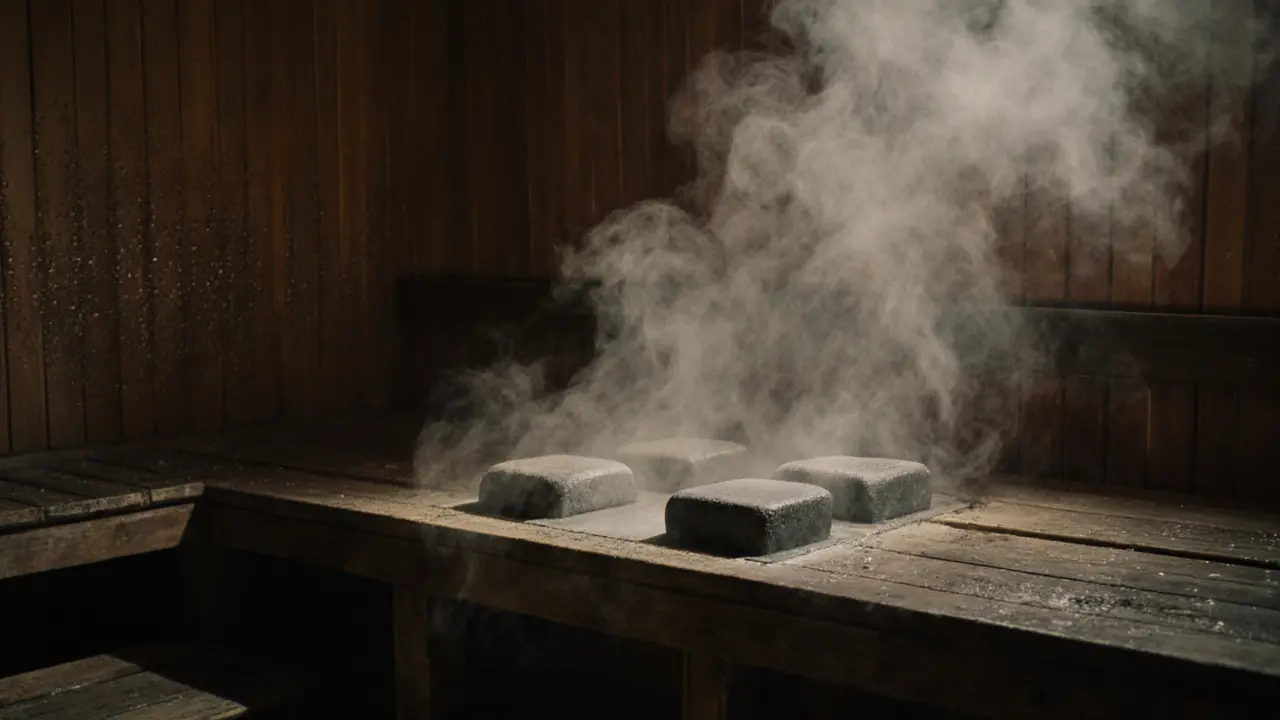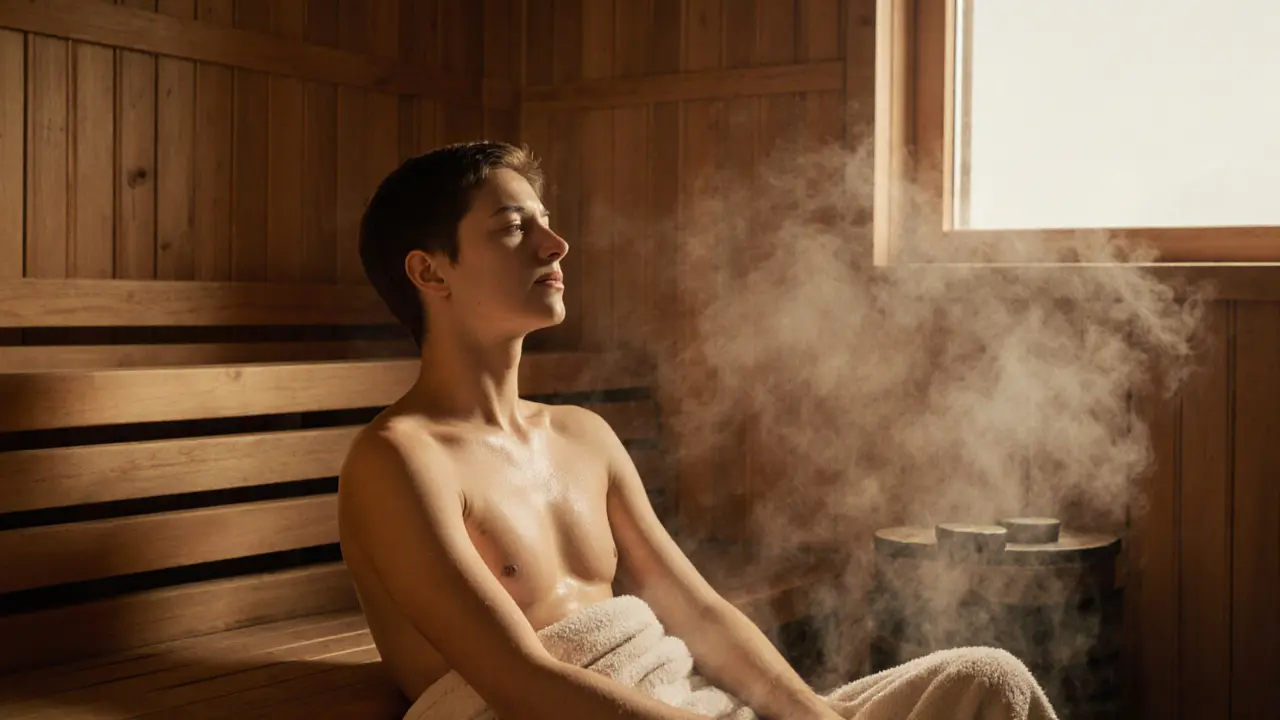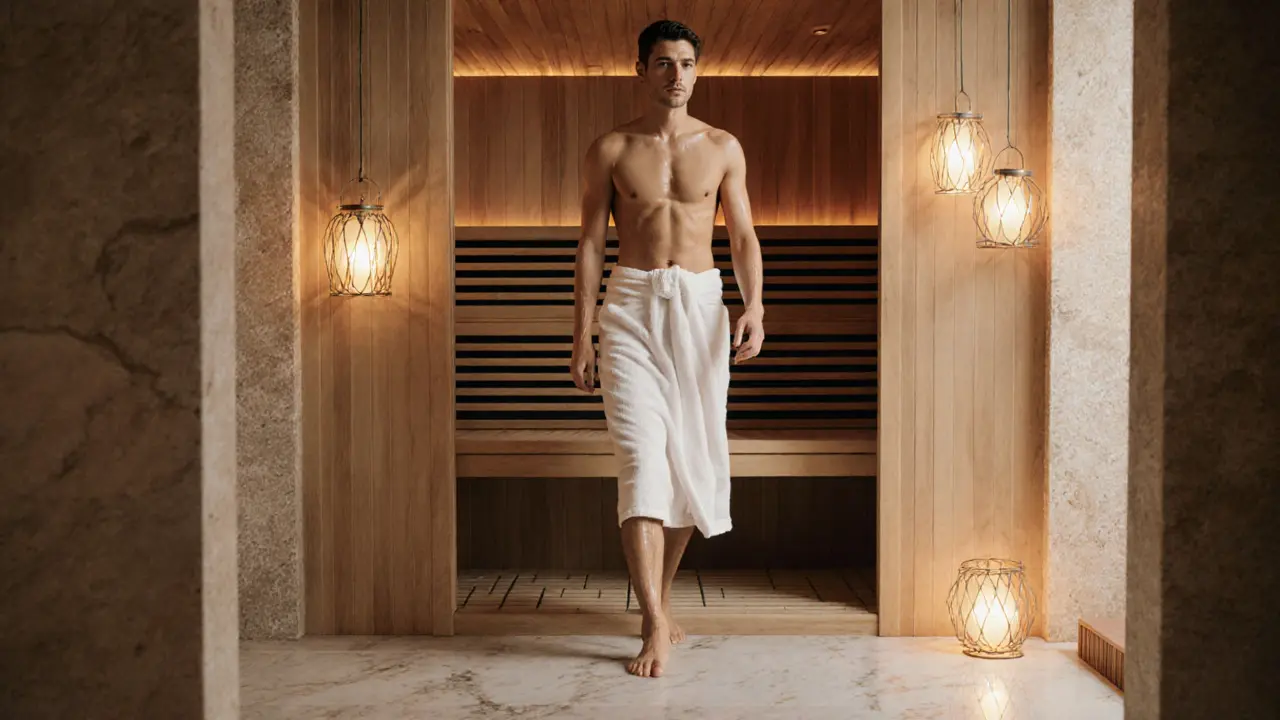Is Sauna Actually Good for You? The Real Benefits in Dubai’s Climate
When you’re sweating through a 45°C afternoon in Dubai, the last thing you might think about is stepping into a hot room on purpose. But sauna isn’t about escaping heat-it’s about using it. In a city where the sun rules the sky, saunas have quietly become one of the most popular recovery tools for locals and expats alike. Whether you’re a fitness enthusiast, a desk worker with stiff shoulders, or just someone trying to reset after a long week, the question isn’t whether sauna is good for you-it’s how it can work for your body in this climate.
Understanding the Basics of Sauna
Origins and History
Saunas didn’t start in luxury spas-they started in Finland, where people built wooden rooms to heat up, sweat, and cool off in icy lakes. It wasn’t luxury; it was survival. The heat cleaned the body, relaxed muscles after hard labor, and brought families together. Today, that same tradition lives on in Dubai, where modern saunas blend ancient Finnish design with Middle Eastern hospitality. You’ll find them in high-end hotels, wellness centers, and even private villas. The core idea hasn’t changed: heat as a tool for renewal.
Core Principles or Components
A traditional sauna uses dry heat-usually between 70°C and 100°C-with low humidity. Some places, especially in Dubai, offer infrared saunas too, which use light to heat your body directly instead of the air. Both types trigger a deep sweat, which helps your body release toxins, increase circulation, and calm your nervous system. The key isn’t just heat-it’s the rhythm: heat, rest, cool down. Repeat. That cycle is what makes it work.
How It Differs from Related Practices
People often confuse saunas with steam rooms or hammams. Here’s how they stack up:
| Practice | Key Feature | Primary Benefit |
|---|---|---|
| Sauna | Dry heat (70-100°C), low humidity | Deep muscle relaxation, cardiovascular boost |
| Steam Room | Wet heat (40-50°C), 100% humidity | Respiratory relief, skin hydration |
| Hammam | Warm, humid, with scrubbing and soap rituals | Exfoliation, detox, cultural experience |
In Dubai’s dry desert air, the sauna’s low humidity feels more comfortable than a steam room. Many locals prefer it because it doesn’t leave you feeling soggy-just clean and light.
Who Can Benefit from Sauna?
Almost anyone can benefit-unless they have specific health conditions (more on that later). Athletes use it to recover faster. Office workers find relief from chronic neck and back pain. People managing stress report better sleep after regular sessions. Even those with mild hypertension find that controlled heat helps regulate blood pressure over time. In Dubai, where stress runs high and recovery is often overlooked, sauna offers a simple, non-drug way to reset.
Benefits of Sauna for Body and Mind
Stress Reduction
When you sit in a sauna, your body releases endorphins-the same chemicals that make you feel good after a run or a laugh with friends. Your heart rate rises slightly, mimicking light exercise, while your muscles loosen and your mind quiets. After 15-20 minutes, you don’t just feel warm-you feel calm. Studies show regular sauna use lowers cortisol, the stress hormone. In a city that never sleeps, that kind of reset is priceless.
Enhanced Recovery
After a tough workout, inflammation and muscle soreness are normal. Sauna heat increases blood flow, helping deliver oxygen and nutrients to tired muscles while flushing out lactic acid. Many Dubai-based athletes-runners, CrossFit fans, even professional soccer players-use saunas as part of their daily recovery routine. It’s not magic, but it’s science: improved circulation equals faster repair.
Emotional Well-Being
Sauna isn’t just physical. It’s a quiet space. No phones. No meetings. No kids. Just you, the heat, and your thoughts. That stillness helps break the cycle of anxiety and overthinking. People in Dubai who practice sauna regularly often say they feel more centered, less reactive. It’s not therapy, but it acts like a daily mindfulness pause.
Practical Applications
Think about your week. You’re stuck in traffic. Your back aches. You can’t sleep. You feel drained. A 20-minute sauna session can help with all of it. It’s not a cure-all, but it’s a practical tool that fits into a busy life. You don’t need hours. Just 15-30 minutes, 2-3 times a week, and you’ll notice the difference.
| Benefit | Description | Impact |
|---|---|---|
| Improved Circulation | Heat expands blood vessels, increasing flow | Reduces muscle soreness, supports heart health |
| Better Sleep | Core body temperature drops after sauna, signaling sleep | Deeper, more restful sleep within weeks |
| Detox Support | Sweating helps eliminate heavy metals and toxins | Clearer skin, reduced bloating |
| Immune Boost | Heat mimics mild fever, stimulating white blood cells | Fewer colds, faster recovery from illness |
What to Expect When Engaging with Sauna
Setting or Context
In Dubai, saunas are often part of a larger spa experience-think marble floors, soft lighting, and the quiet hum of water features. But you don’t need luxury. Even a home infrared sauna in your bathroom works. The key is cleanliness and comfort. Avoid crowded times. Early morning or late evening is best. Many gyms and wellness centers in Dubai offer private sauna slots, which are worth the extra cost if you value peace.
Key Processes or Steps
Here’s the standard rhythm:
- Shower first-clean skin sweats better.
- Enter the sauna, sit or lie down, and relax. No phone.
- Stay for 15-20 minutes. If you feel dizzy, step out.
- Cool down: take a lukewarm shower, then rest for 5-10 minutes.
- Drink water. Repeat if you feel good.
Don’t rush. The magic happens in the quiet between heat and cool.
Customization Options
Not everyone likes the same heat. Some prefer dry heat (Finnish sauna), others like infrared (gentler, penetrates deeper). Some add eucalyptus oil to the stones for a calming scent. In Dubai, many spas offer salt-infused saunas or aromatherapy options. Pick what feels right. There’s no wrong way-just what works for you.
Communication and Preparation
Always tell the spa staff if you’re new, pregnant, or have a heart condition. They’re trained to help. Drink water before and after. Avoid alcohol. Wear a towel, not swimwear. And don’t feel pressured to stay longer than you’re comfortable. Your body knows better than any timer.

How to Practice or Apply Sauna
Setting Up for Success
If you’re trying a sauna for the first time, start slow. Choose a place with good reviews. Avoid peak hours. Bring a towel, water, and maybe a book or journal. The goal isn’t to sweat buckets-it’s to feel better afterward.
Choosing the Right Tools/Resources
For home use, infrared saunas are popular in Dubai because they run cooler (50-60°C) and fit in small spaces. Look for models with low EMF emissions. If you’re using a spa, check if they use clean, well-maintained equipment. Ask if they disinfect between users. Quality matters.
Step-by-Step Guide
- Hydrate well before your session.
- Shower and dry off.
- Enter the sauna, sit comfortably.
- Close your eyes, breathe slowly.
- Stay 15-20 minutes.
- Step out, cool down gently.
- Drink water. Rest for 10 minutes.
- Repeat 2-3 times a week.
Tips for Beginners or Couples
First-timers: Don’t aim for the hottest room. Start with 10 minutes. Listen to your body. If you feel lightheaded, leave. Couples can use sauna time as a quiet bonding ritual-no talking, just presence. It’s a rare chance to just be together without distractions.
Safety and Ethical Considerations
Choosing Qualified Practitioners/Resources
In Dubai, reputable spas follow strict hygiene standards. Look for places with certified staff, clean facilities, and clear safety protocols. Avoid places that don’t ask about your health or offer no privacy. Your comfort is non-negotiable.
Safety Practices
Here’s how to stay safe:
| Practice | Purpose | Example |
|---|---|---|
| Hydrate before and after | Prevent dehydration | Drink 500ml water before entering |
| Limit session to 20 minutes | Avoid overheating | Use a timer |
| Never use alone if new | Ensure help is nearby | Visit during staffed hours |
| Don’t use after heavy drinking | Reduce strain on heart | Wait 24 hours after alcohol |
Setting Boundaries
If you’re uncomfortable with nudity, ask for a private room. If the heat feels too intense, say so. No one should pressure you. Your body, your rules.
Contraindications or Risks
Don’t use a sauna if you’re pregnant, have unstable heart disease, severe hypertension, or are recovering from a recent stroke. People with implants (pacemakers, metal joints) should check with their doctor. If you feel dizzy, nauseous, or your heart races, get out immediately. Sauna is safe for most-but not for everyone.
Enhancing Your Experience with Sauna
Adding Complementary Practices
Pair sauna with cold immersion-like a cool shower or even a plunge pool. That contrast boosts circulation even more. Or follow it with light stretching or meditation. Many Dubai wellness centers offer post-sauna yoga or breathing sessions. It doubles the calm.
Collaborative or Solo Engagement
Sauna can be deeply personal or quietly social. Some prefer silence. Others enjoy light conversation. Both are fine. In Dubai, many couples use it as a weekly ritual. It’s not about talking-it’s about sharing space.
Using Tools or Props
A wooden bench cushion makes sitting more comfortable. A small towel for your head helps. Some like to use a wooden ladle to sprinkle water on hot stones for a burst of steam. Keep it simple. You don’t need gadgets-just awareness.
Regular Engagement for Benefits
One session won’t change your life. But three times a week? That’s when you start to notice: better sleep, less tension, more energy. Think of it like brushing your teeth. Consistency is the secret.

Finding Resources or Experts for Sauna
Researching Qualified Experts/Resources
Look for spas with certified wellness staff. Check Google reviews for mentions of cleanliness, staff knowledge, and customer care. In Dubai, places like The Spa at Burj Al Arab, Talise Ottoman, or even high-end hotel gyms are reliable. Avoid places with no staff or unclear pricing.
Online Guides and Communities
Reddit’s r/sauna and wellness blogs like Healthline offer solid, science-backed info. Local Dubai Facebook groups like “Dubai Wellness Community” are great for real-user tips and hidden gems.
Legal or Cultural Considerations
Dubai has strict rules about modesty. Most spas offer private rooms or gender-specific hours. Always respect local norms. Public nudity is not allowed-even in saunas. Towels are mandatory.
Resources for Continued Learning
Books like The Finnish Way by Katja Pantzar or Heat by Dr. Andrew Huberman (available on YouTube) explain the science simply. No need to overcomplicate it-start with one session and see how you feel.
FAQ: Common Questions About Sauna
What to expect from sauna in Dubai’s heat?
You might think it’s too hot, but Dubai’s dry climate actually makes sauna feel more comfortable than humid environments. Expect to sweat heavily-this is normal. You’ll feel relaxed, not exhausted. Most people leave feeling lighter, calmer, and surprisingly refreshed. Don’t expect instant results, but after a few sessions, you’ll notice better sleep and less muscle stiffness.
What happens during a sauna session?
You enter a warm room, sit or lie down, and relax. Your body temperature rises slightly, causing you to sweat. Blood vessels expand, improving circulation. Your heart rate increases a bit, similar to light exercise. After 15-20 minutes, you exit, cool down with a shower, and rest. The whole process takes 30-45 minutes. There’s no massage, no music-just stillness and heat.
How does sauna differ from steam room or hammam?
Sauna uses dry heat (70-100°C), which is better for deep muscle relaxation and heart health. Steam rooms use wet heat (40-50°C), great for clearing sinuses and hydrating skin. Hammams are more like a full-body ritual-scrubbing, soap, and steam-often lasting over an hour. In Dubai, sauna is preferred for recovery; hammam is for pampering. They serve different needs.
What is the method of sauna?
The method is simple: heat, rest, cool down. You sit in a heated room for 15-20 minutes, then step out to cool your body with a lukewarm shower or air. Rest for 5-10 minutes. Repeat if desired. The key is rhythm, not intensity. You’re not trying to endure heat-you’re letting it work with your body. No special skills needed.
Is sauna suitable for beginners?
Absolutely. Start with 10 minutes at a lower temperature. Many Dubai spas offer infrared saunas, which are gentler and perfect for first-timers. Drink water before and after. Don’t rush. Listen to your body. If you feel okay, you’re doing it right. Beginners often find it easier than they expect-and end up coming back.
Conclusion: Why Sauna is Worth Exploring
A Path to Calm in a Busy City
In a place where the pace never slows, sauna offers a rare pause. It’s not about luxury-it’s about listening to your body. Whether you’re recovering from a workout, chasing better sleep, or just needing quiet time, sauna gives you back what the city takes: stillness.
Try It Mindfully
Start small. One session. No pressure. See how you feel afterward. If it helps, make it part of your routine. Always listen to your body-and talk to your doctor if you have health concerns.
Share Your Journey
Tried sauna in Dubai? Share your experience in the comments. What did you notice? Did it help you sleep? Ease your pain? Follow this blog for more simple wellness tips that actually work in this city.
Some links may be affiliate links, but all recommendations are based on research and quality.
Word count: 1,682
Suggested Images
- A person relaxing in a wooden sauna with soft lighting, towel on lap, eyes closed.
- Steam rising from hot stones in a traditional Finnish sauna, with wooden benches.
- A couple sitting side-by-side in a private sauna, smiling quietly, no talking.
- Close-up of water droplets on skin after a sauna session, natural light.
- A spa reception area in Dubai with sauna sign, minimalist design, marble floors.
Suggested Tables
- Comparison of Sauna vs. Steam Room vs. Hammam
- Key Benefits of Sauna Use
- Sauna Safety Tips



akarsh chauhan
November 26, 2025 AT 14:22While the article presents a romanticized view of sauna culture, it fails to address the fundamental physiological risks inherent in exposing the human body to extreme thermal stress in an already hyper-arid environment. The claim that sauna ‘helps detoxify’ is a pseudoscientific fallacy; the liver and kidneys perform detoxification, not sweat glands. Furthermore, the assertion that sauna improves cardiovascular health is grossly oversimplified, ignoring contraindications for individuals with undiagnosed arrhythmias or endothelial dysfunction. This is wellness theater masquerading as evidence-based practice.